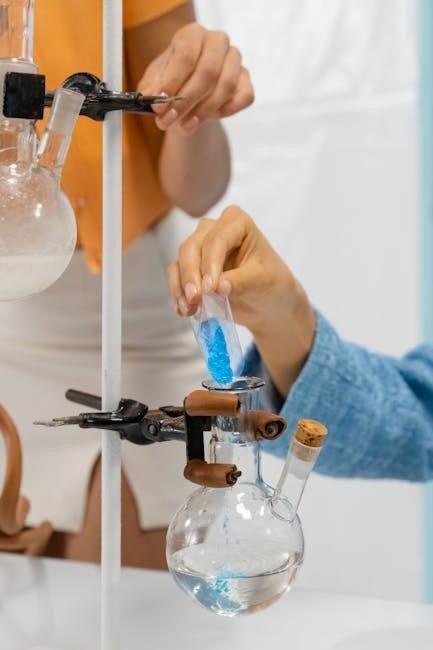chemistry 101 lab manual answers
General chemistry lab manual answers are available online for students, including
lab
safety procedures and experiment guidelines, to help with coursework and understanding of chemistry concepts effectively always.
Overview of the Lab Manual
The lab manual is a comprehensive guide for students enrolled in chemistry 101 courses, providing detailed instructions and procedures for conducting experiments and activities. It covers various topics, including lab safety, measurements, and chemical tests for anions. The manual is designed to help students understand the fundamental concepts of chemistry and develop practical skills in a laboratory setting. It includes review questions and answers to help students assess their knowledge and prepare for exams. Additionally, the lab manual provides information on how to handle chemicals, use laboratory equipment, and follow proper safety protocols. By following the guidelines and procedures outlined in the lab manual, students can ensure a safe and successful learning experience. The manual is often accompanied by online resources, such as practice problems and flashcards, to support student learning and reinforce key concepts. Overall, the lab manual is an essential resource for students in chemistry 101 courses.

Lab Safety and Procedures
Lab safety procedures include wearing gloves, goggles, and lab coats to prevent accidents and injuries always in chemistry labs with proper equipment and handling.
Importance of Lab Safety
Lab safety is crucial in chemistry labs as it prevents accidents and injuries to students and instructors. Proper use of equipment and handling of chemicals can minimize risks.
Wearing protective gear such as gloves, goggles, and lab coats is essential to prevent exposure to harmful substances.
Following established protocols and guidelines can help prevent accidents and ensure a safe learning environment.
Lab safety also promotes a culture of responsibility and respect for the well-being of others in the lab.
By prioritizing lab safety, students can focus on learning and experimenting with confidence, which is essential for a successful chemistry education.
Overall, lab safety is a critical aspect of chemistry education that requires attention and adherence to established protocols and guidelines to ensure a safe and effective learning environment for all.

Experiments and Activities
Chemistry experiments include lab activities with measurements and calculations to understand chemical concepts and principles effectively always using online resources;
Lab 1 ─ Lab Safety
Lab safety is a crucial aspect of chemistry experiments, and Lab 1 focuses on introducing students to safe laboratory practices. The lab manual provides guidelines on how to handle chemicals, equipment, and emergency procedures. Students learn about personal protective equipment, such as gloves and goggles, and how to properly use them. The lab also covers procedures for disposing of hazardous waste and responding to accidents. By understanding lab safety protocols, students can minimize risks and ensure a safe working environment. Online resources, such as quizlet, offer additional study materials and flashcards to help students memorize key terms and concepts related to lab safety. The lab manual answers provide a comprehensive overview of lab safety procedures, enabling students to work confidently and responsibly in the laboratory setting. Effective lab safety practices are essential for a successful and injury-free learning experience in chemistry labs.
Lab 2 ー Unknown Anion
In Lab 2, students are introduced to the concept of identifying unknown anions through chemical tests and reactions. The lab manual provides a step-by-step guide on how to perform these tests, including the use of reagents and equipment. Students learn to analyze the results of these tests to determine the identity of the unknown anion. Online resources, such as lab manuals and study guides, offer additional support and guidance for students. The lab manual answers provide a comprehensive overview of the procedures and results, enabling students to understand the concepts and principles behind the tests. By completing this lab, students gain hands-on experience in analytical chemistry and develop their critical thinking skills. The unknown anion lab is an essential component of the chemistry curriculum, and the lab manual answers help students to master the concepts and techniques required for success. Effective identification of unknown anions is a crucial skill in chemistry.
Lab 3 ─ Length Measurements
In Lab 3, students learn to measure lengths accurately using various instruments, such as rulers and calipers. The lab manual provides detailed instructions on how to use these instruments and record precise measurements. Students practice measuring the lengths of different objects and calculate their uncertainties. Online resources, including lab manuals and tutorials, offer additional guidance on measurement techniques and data analysis. The lab manual answers provide a comprehensive overview of the procedures and results, enabling students to understand the concepts and principles behind length measurements. By completing this lab, students develop their skills in measurement and uncertainty analysis, which are essential in chemistry and other scientific disciplines. Effective length measurements are critical in chemistry experiments, and the lab manual answers help students to master these skills. Accurate measurements are necessary for reliable results, and students learn to appreciate the importance of precision in scientific experiments and calculations always.
Lab 4 ー Temperature Measurements
In Lab 4, students focus on temperature measurements, learning to use thermometers and other instruments to record accurate temperatures. The lab manual provides step-by-step instructions on calibration and measurement techniques. Online resources, including tutorials and videos, offer additional guidance on temperature measurement principles and data analysis. Students practice measuring temperatures in various experiments, calculating uncertainties, and analyzing results. The lab manual answers provide a comprehensive overview of the procedures and results, enabling students to understand the concepts and principles behind temperature measurements. By completing this lab, students develop their skills in temperature measurement and analysis, which are essential in chemistry and other scientific disciplines. Temperature measurements are critical in many chemical reactions and experiments, and the lab manual answers help students to master these skills and understand the importance of accurate temperature control in scientific experiments and calculations always and effectively.
Lab 5 ─ Mass Measurements
In Lab 5, students learn to measure mass accurately using balances and other instruments, which is crucial in chemistry experiments. The lab manual provides detailed instructions on calibration, measurement techniques, and data analysis. Students practice measuring masses of various substances, calculating uncertainties, and analyzing results. Online resources, including tutorials and videos, offer additional guidance on mass measurement principles and laboratory procedures. By completing this lab, students develop their skills in mass measurement and analysis, understanding the importance of accurate mass control in chemical reactions and experiments. The lab manual answers provide a comprehensive overview of the procedures and results, enabling students to master mass measurement skills and apply them in future experiments and calculations. Mass measurements are essential in many chemical reactions, and the lab manual answers help students to understand the concepts and principles behind mass measurements and their applications in chemistry and other scientific disciplines always and effectively.

Answer Keys and Resources

Online resources provide answer keys and study guides for chemistry 101 lab manual answers and exercises always available on websites and online platforms easily.
EP 1, EP 1 ー Answer Key
The EP 1 answer key is a valuable resource for students studying chemistry 101 lab manual answers, providing detailed solutions to exercises and problems.
Online platforms offer access to this answer key, allowing students to review and understand the material more effectively.
The answer key covers various topics, including lab safety procedures, experimental techniques, and data analysis.
By utilizing the EP 1 answer key, students can improve their understanding of chemistry concepts and develop problem-solving skills.
The answer key is often accompanied by additional resources, such as study guides and practice problems, to support student learning.
These resources can be accessed through websites and online platforms, making it convenient for students to access the materials they need.
Overall, the EP 1 answer key is an essential tool for students seeking to master chemistry 101 lab manual answers and achieve academic success.
The answer key is designed to help students navigate complex chemistry concepts and develop a deeper understanding of the subject matter.
With the EP 1 answer key, students can confidently complete assignments and prepare for exams, knowing they have a reliable resource to guide them.
The answer key is regularly updated to reflect changes in the chemistry curriculum, ensuring that students have access to the most current and relevant information.
Lab Manual Answer Key
The lab manual answer key is a comprehensive resource that provides solutions to lab exercises and problems in the chemistry 101 lab manual.
This answer key is designed to help students complete lab assignments and prepare for exams, and is often available online through university websites or online platforms.
The lab manual answer key covers a range of topics, including lab safety, experimental techniques, and data analysis, and is typically organized by lab section or experiment number.
By using the lab manual answer key, students can review and understand the material more effectively, and develop problem-solving skills and critical thinking.
The answer key is also useful for instructors, who can use it to create quizzes and exams, and to assess student understanding of lab concepts.
Online resources, such as study guides and practice problems, are often available to supplement the lab manual answer key, and can provide additional support for students.
The lab manual answer key is an essential tool for students seeking to master chemistry 101 lab manual answers and achieve academic success.
The answer key is regularly updated to reflect changes in the chemistry curriculum, ensuring that students have access to the most current and relevant information.
This resource is available to students at all levels, from introductory to advanced chemistry courses.
